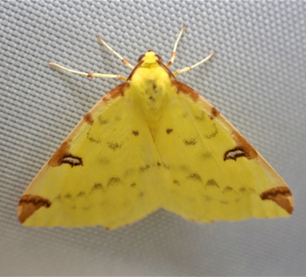By John Maxen
Following Laura Harrison’s interesting article of observing butterflies during lockdown in October’s Sunbury Matters, I thought I would relate my own experience in a new hobby taken up during lockdown – Moth Trapping. There are over 2,500 species of moths in the UK, and are generally demarcated into two main groups, macros (large), and micros (small), although like many other aspects, it is not a hard and fast rule and some species are in one group that perhaps might be considered to be part of the other.
People ask what the main differences are be-tween butterflies and moths. Again, this is not a hard and fast rule and should be not be used as the only method of identification as there are many exceptions, but;
The antennae of butterflies usually tend to be ‘club-shaped’ while those of moths tend to be feathery or tapering
The wings of butterflies are folded verti-cally over their backs, while the wings of moths are held horizontally when at rest
Butterflies tend to be day flying, whilst moths are night flying
Butterflies are colourful whilst moths are drab
The largest moth in the UK is the Privet Hawk Moth which is the size of a mouse, and the smallest is Enteucha acetosae which is about 3-4mm long.
Moth trapping has been known about for hun-dreds of years and there is a quote in Shake-speare’s Merchant of Venice, Act 11, Scene 9, that refers to moths being attracted to light. I began trapping in April 2020 and, to date, have trapped and identified over 170 species of moth from my back garden in Lower Sun-bury. There are many varieties of trap, some more sophisticated than others, both battery and mains charged. I use a 20W uv bulb in a simple box structure with flaps that reduces the opportunities for moths escaping. There are several theories why moths are attracted to light. One is that moths are able to use the moon to orientate, which is why a cloudy night may be better than a night with a full moon. I set up at dusk and the box (with sev-eral upturned egg boxes inside so the moths can hide) is checked in the morning. You nev-er know what might appear, common or rare. Individuals not immediately identifiable are put in jars for later photographing and are then released in a safe place. No specimen is damaged or killed. A few pictures below show the variety of moths that have appeared in the garden, many of which have specific flying periods (periodicity), so it is possible to follow the seasons through the number and variety of moths observed. A checklist is kept, and this is reported to the county recorder for Herts and Middlesex so that species distribution can be entered into a data-base.
This has proved to be an absorbing hobby. I never know what may appear, (I have discovered one species new to Middlesex and another of which there were only around 6 previous rec-ords across the UK), and I also know that I am providing data to experts to ensure these fascinating creatures are able to continue to be observed in Sunbury.

